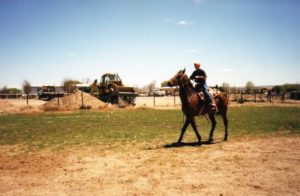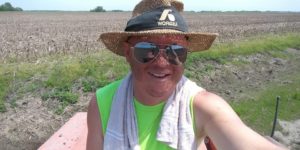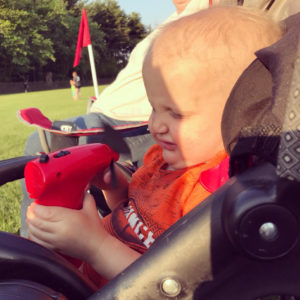It was a long, cold winter for many of us. While we welcome the sunshine and warmer temperatures of spring and summer, we know that not everyone does. Many people with different types of ectodermal dysplasia have hypohidrosis. The soaring temps outside can mean soaring temps inside.
Hypohidrosis is a condition in which the sweat glands don’t work normally or may be diminished in number. Our sweat glands are like our body’s own natural air conditioning system. Without them, we cannot regulate our body temperature.
Cooling Resources for Hypohidrosis
Our Cooling Guide is a great resource for learning more about what hypohidrosis is, signs of overheating, the need for air conditioning and various cooling products. It answers all of the frequently asked questions about not being able to sweat normally.
It’s exciting to think about the next generation of children with x-linked hypohidrotic ectodermal dysplasia, may have a treatment option that restores their sweat glands. But, for our families now, it’s important to share practical tips for managing the heat. We best learn from one another!
Our National Foundation for Ectodermal Dysplasias (NFED) staff has talked to thousands of families over the years about how they live their lives when they cannot sweat. All agree that it can be trial and error to learn what works best and for which situations. What works for one person doesn’t work for all or in all climates or at all ages. But, not being able to sweat definitely doesn’t have to be the reason to not try things.
Let Them Try. Have Water Ready.
Parents of children with hypohidrosis, we encourage you to let them explore outside, try sports and be active. Cody Snell is living proof that they can do it. The New Mexico resident played sports year-round as a kid and worked outside in 100+ temps. He now has a daughter who also cannot sweat.

“Don’t let it limit what you do. The kids can do everything. They just need a few extra resources and to be encouraged to be outgoing and embrace it.”

Whatever cooling options you choose, water – and lots of it – needs to be top on your list. Charlie Richter, who is affected by XLHED, is a farmer in southwest Illinois. He recently posted in our Facebook group.
“I’m affected by HED, and been dealing with it for 40 years now. For any new parents out there let me assure you, your kids can do and become whatever they want regardless of their condition. Today, I’m making ditches and it’s 86 degrees. I brought along plenty of water to drink and to wear.”
While we typically talk about XLHED when it comes to no sweating, there are other types of ectodermal dysplasia that also involve hypohidrosis. Heather McKelvie is affected by ectrodactyly-ecctodermal dysplasia-clefting (EEC) syndrome and also cannot sweat. She grew up without air conditioning and talks about keeping cool in heated situations.
“Despite not being cut out to handle the heat, gardening has been one of my lifelong passions. I spent several years working on farms, growing everything from squash and tomatoes to daylilies and tropical citrus. In the earliest days of farm work, I suffered a lot. Some days I would come home with a raging headache and quivering limbs. I soon learned to bring lots of water and to force myself to drink as much as I could, even if I didn’t feel thirsty.”
I learned to take an old, long-sleeved, cotton button-down shirt and plunge it into a bucket of cold water. Then I’d wring it ever so slightly, and put it on over my tank top. The cool fabric would suck the heat out of my arms and torso almost instantly. Of course the shirt would dry out within minutes, but it was more comfortable for me than the vests or other things I tried.”
Chill Out in the Car
Maintaining your body temperature when you have hypohidrosis is a year-round challenge. But it can be especially tough during the summer months.
For the littlest people riding in the back seat of vehicles or in car seats (especially if they are rear facing), having a plan to keep them cool is especially important. As the temps escalate outside, the temperature inside of your parked vehicle can climb even higher.
Here are ideas that our families shared in our Facebook group on how to keep riders in the back seat cool.
- Travel with a large cooler of ice and water and pre-soaked t-shirts. They can hold the frozen water bottles if it doesn’t irritate their skin. As the ice melts, they can drink it, too, keeping them cool on the inside and out.
- Carry a spray mist bottle, such as a Misty Mate.
- If your vehicle doesn’t have rear air conditioning, use a noggle to help push the air from the front vent to the back seat.
- Attach a clip-on stroller fan to the headrest of the front seat. Fans can be battery operated or plug into a cigarette lighter to help blow more air to the back. One family said that before they get in the car, they turn on the AC and leave the back windows cracked for about five minutes. This pushes the hot air out of the car.
- Place a cooling towel around the child’s neck. We have one for purchase in our NFED store. You can also find lots of options online such as Mission Enduracool.
- Use shades on the window to block out the sun and heat.
- Let the child take off their shoes in the car.
- Use ice packs under car seat fabric. Be careful the skin doesn’t get cold burn. Or, you may purchase car seat coolers such as these.
- Wear cooling headbands that you can find online, such as these on Etsy.
- Install ceramic tint on the back windows.
- Purchase a vehicle with rear AC.
- Choose a lighter color car when purchasing.
- Install a remote starter for your automobile. Cool down the vehicle several minutes before getting in with your child.

Sarah and Everett Hamilton have two daughters who are just like daddy. They have XLHED and thus, hypohidrosis. But, the Hamiltons never let it stop them from doing what they love, Sarah said.
“We still live a normal life. It’s not complicated. Just pack what you need to stay cool. Ectodermal dysplasia is our norm. We don’t let it stop us.”
What do you to keep your loved ones with hypohidrosis cool? Tell us in the comments below so that we can all learn.
